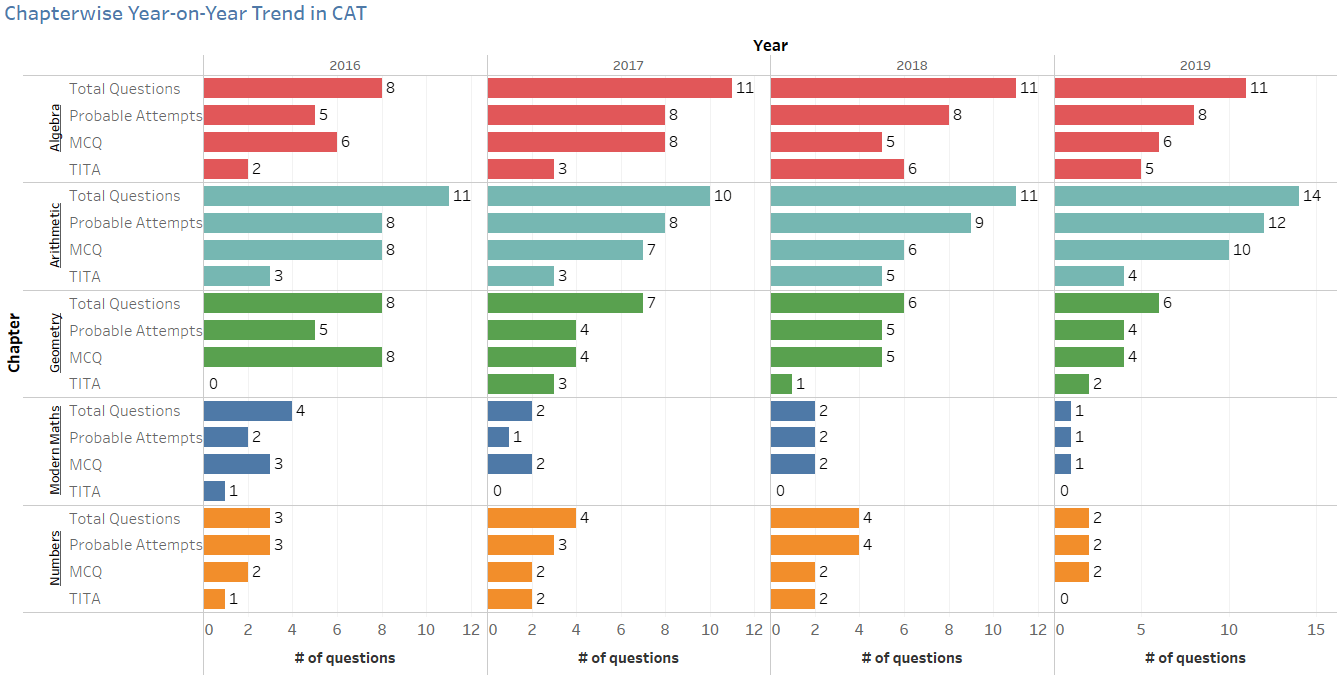Start by understanding the exam pattern
| Header | Description |
| Total Number of questions | 34 |
| Type of questions | 24-27 MCQ with negative marking 7-10 Non-MCQ with no negative marking |
| Marking Scheme | +3 / -1 |
| Total Time | 60 Minutes |
| Level of Difficulty | Moderately easy to Difficult |
The syllabus for QA is broadly divided into five chapters: Arithmetic, Algebra, Geometry, Modern Maths and Numbers. Having a fair bit of understanding about the sub-topics is of great help.
| Chapter | Sub-Topics |
| Arithmetic | Averages, Mean Median Mode, Percentages, Ratio and Proportion, Simple and Compound Interest, Profit and Loss, Mixtures and Allegations, Time and Work, Time Speed and Distance |
| Algebra | Basics Algebraic Formulae, Linear Equations, Quadratic Equations, Higher Degree Equations, Inequalities, Logarithm, Functions |
| Geometry | Lines and Angles, Triangles – Basic Concepts, Polygons, Circles, Solids/Mensuration – 3D Geometry, Coordinate Geometry, Trigonometry |
| Modern Maths | Sequence and Series, Binomial Theorem, Set Theory, Permutation and Combination, Probability |
| Numbers | Basics of Numbers, Properties of Numbers, Divisibility Rules, Divisibility and Factors, Highest Common Factor and Lowest Common Multiple, Finding Out the Last Digit, Finding Out Last Two Digits, Number of trailing zeroes, Finding out Remainders, Base Systems |
It makes all the more sense now to evaluate the focus areas by looking at the past CAT trends in Quantitative Ability. I shall be evaluating the CAT exam from 2016 onwards. The below graph shows the chapter-wise split of the total questions appearing each year in CAT. As is evident, Arithmetic, Algebra and Geometry form the chunk of the questions in QA and therefore it is preliminary to practice these three topics the most. Expect close to 80% questions from these three chapters. The remaining 20% is taken up by Modern Maths and Number System.

My strategy
I started by giving a mock test without any practice to check where I currently stand. I got a decent score of around 90-95%ile in QA in this mock. I understood that I need to work on the key scoring areas to take this score up as I had some basic understanding of the concepts. My focus thus turned to speed and smart selection of questions. This can be achieved only through a thorough analysis of mock tests.
Giving numerous mock tests made me realize that Geometry was one area in particular that took a lot of my time. I started filtering out questions in Arithmetic and Algebra which I can do in one go and then would keep the difficult ones for later on. I, therefore, ended up completing my QA section in two cycles - one for the easier questions and the other for the marked for later/difficult questions.
In my other articles as well, I have mentioned the 80%-80% rule that refers to an 80% attempt at an 80% accuracy to get a 99+%ile. Since Algebra, Arithmetic and Geometry take up 80% of the questions, I could leave some (~2 difficult questions) in Geometry and cover the rest in Modern maths and Number system (easier than Geometry) to get an equivalent (or probably more) score.
Recommended: Most Important Topics For CAT 2020's Quant Section - Analysing Past Years' CAT Papers
Which questions to attempt?
Across the CAT exam, there are two types of questions - MCQ and Type In The Answers (TITA) questions. In QA particularly, in my opinion, TITA questions should be attempted as they are pretty easy, standard and don't need much calculation if you have a strong logic. But again, attempt only if you are sure you can do it - DO NOT DO TITA IF IT TAKES A LOT OF TIME. QA is all about timing your questions right.
Questions based on Time, Speed and Distance, P&L, Ratio & Proportions, Equations, Ages, Percentages, Co-ordinate geometry are easy to solve. Simple/Compound Interest, Inequalities, Finding the area, Circles, etc. might take some time. There is no set framework that fits all. It varies from candidate to candidate.
The below graph shows the chapter-wise MCQ/TITA split along with the probable questions that you should attempt in order to get a good score. Accuracy is also very important here. You might attempt less with higher accuracy to get better scores.

My strategy
I would attempt easy to moderate level questions in Arithmetic, Algebra, Modern maths and Number system first and would leave Geometry for the last. I usually targeted ~28-30 questions in QA (but that is subjective and depends on the level of difficulty of the problem). I would make sure to attempt close to 90% of the TITA questions as they are easy and standard. A 75% attempt in MCQ with 80-85% accuracy does the rest.
An easy question should take around 1 minute to solve, a moderate level close to 2 minutes and a difficult question ~2.5-3 minutes in QA. Time, my level of confidence with the problem would help me ascertain if I want to attempt it or leave it for the end.
Understand that it's okay to attempt less number of questions with a high accuracy rate. Many people tend to succumb under pressure and make wrong attempts and thus compromising their accuracy.
Finally, I feel that doing good in QA doesn't need some genius-level intellect. While you still have time to prepare for CAT 2020, it's better to start straight away with mock test series and a book to practise problems (Arun Sharma is the most recommended). Evaluate your weak areas and understand the focus points for CAT. Mock Tests would give you a fair bit of idea about frequently asked question types.
I hope my article shall help you make peace with Quant and that you are now able to not just able to focus on the problem, but the right problem that gets you the highest added advantage.
I would love to hear your thoughts on this. Feel free to share your feedback or your own strategies in the comment box below.
All the best!!
:)
***
Read some of the other articles written by Ankit Gupta -









Comments
Huthabhukh Rises
Thank you so much for the post. It helped me.
12 Jun 2020, 02.32 PM